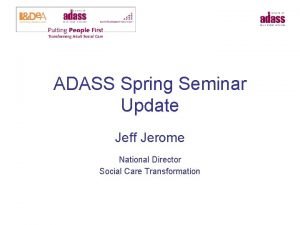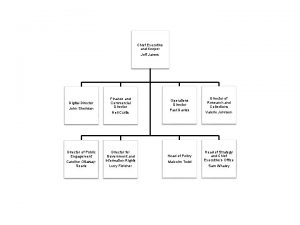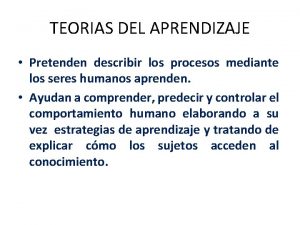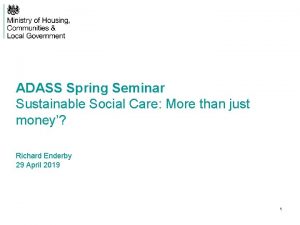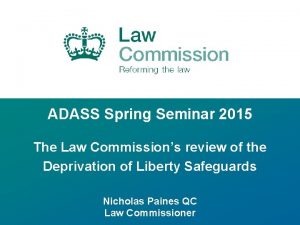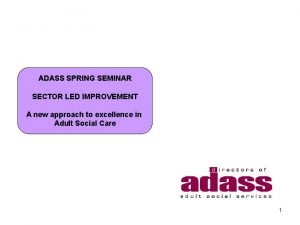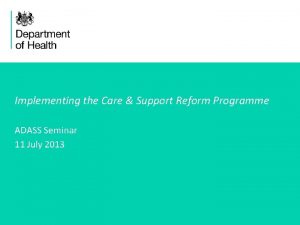ADASS Spring Seminar Update Jeff Jerome National Director


















- Slides: 18

ADASS Spring Seminar Update Jeff Jerome National Director Social Care Transformation

1. Finance IT Systems What are we trying to achieve? • The aim of this project is to help councils to update financial aspects of their information systems, to make these fit for purpose and compatible with personal budgets, the new approach to financial contributions and other key aspects of Putting People First. • The outputs will enable councils to work with their IT suppliers based on a consistent nationally-agreed highlevel specification

Finance IT Systems What will be delivered? • • A description of the core financial process required by councils to implement personal budgets, including financial contributions A high-level specification for information systems making clear what functionality needs to be provided It will outline: • • • core principles - for example, one principle may be that of individualised budget allocation what must be done – this is the core financial process map, any requirements that should be adhered to – an example may be that of allowing ‘split’ payments (a council managed service and a direct cash payment).

Finance IT Systems Who is involved? • PPF Finance Reference Group (which includes representatives from over 14 authorities, Do. H and Social Care Consortium) • IT Vendors (Northgate, Liquid Logic, Core Logic, OLM, Civica, Care. Works etc) • ADASS Personalisation Network When will it be complete? • Final draft presented to IT Vendors on 30 th April • Circulated to ADASS Personalisation Network for comment • Early to mid May final document released

2. Council Workforce Study What are we trying to achieve? • Gathering preliminary information from key ‘advanced’ authorities in order to document their progress in changing their workforce • Findings will be shared with other councils, and it is planned that this information be used as the basis for a more detailed study

Workforce Study What will be delivered? • Answers to questions such as: – What workforce groups were reviewed? – What structural changes to senior and front-line staff were made? – Examples of joint working – Use of independent organisations – Commissioner/provider type considerations – Training, development and retention issues

Workforce Study Who is involved? • 9 Authorities : When will it be complete? • Early to mid May final document released Bury Coventry Essex Kent Leeds Norfolk North Lincs Richmond York

Workforce Study: headlines • Wide variety of approaches taken, ranging from no formal restructure or still thinking), to a full review of both senior management and front-line staff • Joint working: – Norfolk is one of the national pilot sites for the delivery of Integrated Care Organisations. It has six pilot sites based in primary care delivery. Currently creating a joint commissioning team with Health Partners to cover all customer groups – In Coventry the Integrated Intermediate Care Service is hosted by the City Council, and was in the process of its own integration and re-organisation throughout this period – In Richmond the Reablement service is jointly managed in parallel with the Intermediate Care Team. Intention is to merge Reablement with ICT

Workforce Study: headlines • Staff and/or functions being transferred to independent organisations: – Norfolk currently negotiating the potential to create a Trading Company to deliver Care Housing in Norfolk which will include 13 Housing with Care Schemes and 26 Residential Care Homes – Essex has created Local Authority Trading Company ‘Essex. Cares’ with 850 staff TUPE transferred – Richmond, 40% of support planning activity is being transferred to the independent user led sector

Workforce Study Headlines • Were job descriptions reviewed: – Almost every authority reviewed job descriptions and structures as part of their redesign – Coventry created new roles such as an Outcomes Broker – Richmond created new functions in Access Service to broaden the scope and reach of advice and information.

Workforce Study: Headlines • Training, development, recruitment and staff retention issues: – Many authorities actively working with universities to ensure personalisation is embedded into future workforce – Coventry is involved in the development of the Social Work curriculum at Coventry University. Most recently, staff have developed a new Brokerage qualification. Module 1 has been approved by the Curriculum Approval Board and the first cohort will take place later this year – Norfolk has a Strategic Workforce Group on which their Higher Education colleagues sit and have created a Foundation degree in Health and Social Care for Assistant Practitioners and a ‘Passport to Care’ for both PAs/Informal Carers

3. Budget Management What are we trying to achieve? • Very rapid gathering of preliminary information from key advanced authorities in order to document their approach to Budget Management

Budget Management : Headlines • In some cases, traditional ‘panel’ approaches are initially adopted when PB numbers are low, but these do not appear to be sustainable as volume increases • Some authorities have devolved budgets back to service manager level. – In these cases clear spend targets are set for each team (either fortnightly or monthly) – If a team exceeds targets then the reasons for this are reviewed – So far this has reportedly helped foster the right behaviour

4. National Learning Set – Resource Allocation What are we trying to achieve? 1. Benchmarking based on the Policy Document – – A benchmarking tool to assist councils and regions to check their resource allocation methodology against good practice. To be an online facility to cover key areas that include coproduction, system and process, impact on families, learning from experience 2. RAS Tool Calibration and Implementation – – Making the RAS work in a financial environment Cover 6 -8 key areas where improved guidance and good practice required, inc re-calibrating RAS/‘sizing the pot’

National Learning Set: Resource Allocation Who is involved? • 15 councils (all regions are represented), citizen leaders and carer representatives When will it be complete? • Final workshop on June 10 th to confirm and improve products, and decide the process for finalising

5. Personal Budget Implementation Headlines • 38 authorities requested a conversation on support for Personal Budget implementation • 19 authorities have had this conversation, and; • 8 have requested ongoing support

Personal Budget Implementation Support that has been requested includes: – Help with outcome based reviews, since the volume of new people coming in isn’t sufficient to meet NI 130 targets – Holding provider events to help providers understand how they can offer more flexible services – Helping with modelling tools. As authorities move from pilot to mainstream they need to understand what weekly/monthly volumes they should be aiming for – Resource allocation systems. Helping to unblock the situation where an authority thinks a RAS needs to be ‘perfect’ before implementation

6. PSSEX 1 Update Next steps • Implementation of the new PPSEX 1 categories would take place from 2012 -13, following formal consultation with stakeholders and councils, and a period of testing through early implementation. Work to identify how personal budget statements could be developed by councils is already being carried out by ADASS • The proposed timescales for taking forward the PSSEX 1 proposals are: – Share the revised proposal with ADASS finance reference group (DH, April 2010) – Consult the Strategic Improving Information Programme Board (SIIP), on which DH, ADASS and the Information Centre is represented (DH, April 2010) – Consult with councils through the CIPFA working party (CIPFA, June 2010) – Develop and demonstrate the proposed approach, through the TRIPS programme (DH/Information Centre, September – March 2011) – Update proposal to take account of learning from development phase and policy changes (DH, April 2011) – Develop final definitions and data collection forms (Information Centre, April-June 2011) – Publish final proposals (CIPFA, September 2011) – National implementation of the new PSSEX 1 (Councils and Information Centre, April 2012).
 Packing by jerome k jerome
Packing by jerome k jerome Lesson 7 packing
Lesson 7 packing Jeff jerome
Jeff jerome Backup and recovery techniques
Backup and recovery techniques Jeff james director
Jeff james director Clem brohier
Clem brohier Spring, summer, fall, winter... and spring (2003)
Spring, summer, fall, winter... and spring (2003) Autumn winter summer
Autumn winter summer National training seminar
National training seminar El aprendizaje por descubrimiento de jerome bruner
El aprendizaje por descubrimiento de jerome bruner Jerome kevin and seth shared a submarine sandwich
Jerome kevin and seth shared a submarine sandwich Imgesel dönem
Imgesel dönem Nimds
Nimds Liquidity market risk
Liquidity market risk Jerome bruner andamiaje
Jerome bruner andamiaje Jerome 6 and hani 10
Jerome 6 and hani 10 Jerome bruner enactive representation
Jerome bruner enactive representation Bruner bilişsel gelişim
Bruner bilişsel gelişim Jerome and claire are doing the period of a pendulum
Jerome and claire are doing the period of a pendulum


